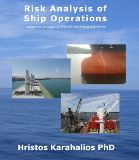Ship Collision Incidents
There are a few factors that contribute to ship collisions. Very rarely is the result of faulty equipment or adverse weather. One of the most common causes of collisions is human error. This can be due to a mistake made by the captain or an OOW. The majority of cases deal with the lack of deck officers' familiarization with bridge equipment and ship's manoeuvring characteristics of a ship. Lack of such skills may be traced to the inappropriate education of seafarers since they are not topics hard to be taught or understand. In addition, recent technological advances have offered seafarers several instruments for navigation. Yet, with new technologies, there is a risk of overloading the deck officers with information and alarms. For instance, over-reliance on AIS may lead OOW to act contrary to COLREGS. On the other hand, seafarers prefer to take shortcuts at their convenience. This behaviour could be due to a lack of awareness about the implications of reckless actions.
Hereunder are some accident investigation cases:
Case 1: Cultural Factors
On March 9, 2015, a collision occurred between a bulk carrier and a tanker at Houston Ship Channel near Morgan's Point, Texas. The investigators felt that cultural factors could contribute to the hesitation of a crewmember to pass information to a pilot or even challenge him. As it is written in the report (National Transportation Safety Board NTSB/MAR-16/01):
"Scientific research also indicates that culture can play a role in bridge resource management. Effective bridge resource management training addresses cultural factors."
Case 2: Overuse of VHF
A collision occurred between two oil tankers in the bay of Algeciras on 11th October 2014 due to poor use of VHF to avoid a collision. The investigators to make the following comments (Claim-13/2015 Report):
"The accident occurred as a result of the coincidence of several failures which stem from human overconfidence, concurrent events failing to comply with several COLREGs rules an incorrect vessel traffic monitoring activities in the bay of Algeciras."
"the available details of the accident show a lack of training on VHF radio communications skills, bridge communication management, COLREGs compliance and Human Resource Management."
Case 3: Insufficient Training
On 7th May 2015, a collision occurred at high sea between a vehicle carrier and a general cargo ship. The marine safety investigation report of Transport of Malta NO. 07/2016 presents the actions that the managers of the vehicle carrier as preventive actions:
- Maritime Resource Management (MRM) Training – The criteria for specific training in MRM has been enhanced to include a requirement for the training to be carried out every five years for masters, chief mates, second and third officers, chief and second engineers, and electricians. Previously, there had been no requirement for MRM refresher courses
- Computer-based training (CBT) training in ColRegs application – A review of the CBT records has been carried out to ensure that the Company specified ColRegs training has been completed by the required individuals, and deficiencies addressed as necessary;
- Additional promotion criteria – In order to facilitate the better appraisal of all shipboard personnel, the Company is considering a 'Crew Training Record Book'. The Book will record task achievement and hence competence standards, as an individual progress along with his/her career path. The Company believes that it will provide objective evidence which will allow serving masters to better assess the comparative competence and experience levels of their officers and crew;
Case 4: Near Miss
While navigating in a two-way water route, a bulk carrier named "A" had a crossing course with another ship called "B". The route was monitored by a VTS and outside its limits, there are shallows. Contrary to Rule 15, the navigation officers agreed to pass starboard to starboard. To achieve this manoeuvring, the Ship "A" had to turn its course on the left, passing from ship "B" to a distance of 0.5 nautical miles. As it is shown in the picture, the ship "A" could remain at its initial course and have a clear port to port pass from ship "B".
‘Conflicting actions may occur in head-on or near head-on encounters where one ship takes avoiding action by turning to port and the other ship by turning to starboard. Rule 8 (a)
See footage of near-miss ship collision
With the use of ECDIS the incident was examined by the DPA who made the following observations:
Findings
- Ship “A” changed course to port side against Rule 15 which states to avoid crossing ahead of the other vessel. In a crossing situation, a ship is required to avoid crossing ahead of a ship on its starboard side, if there is a risk of collision.
- A VHF agreement cannot be made against a COLREG for any reason.
- Safe distance from another ship cannot be less than 1 nautical mile at open sea. Otherwise, speed should be reduced Rule 8(d).
- Rule 17(ii) (referred to the ‘stand-on vessel) should be read together with 17(c) that does not allow a ship to alter its course to port side to avoid collision with another ship crossing from its port side

